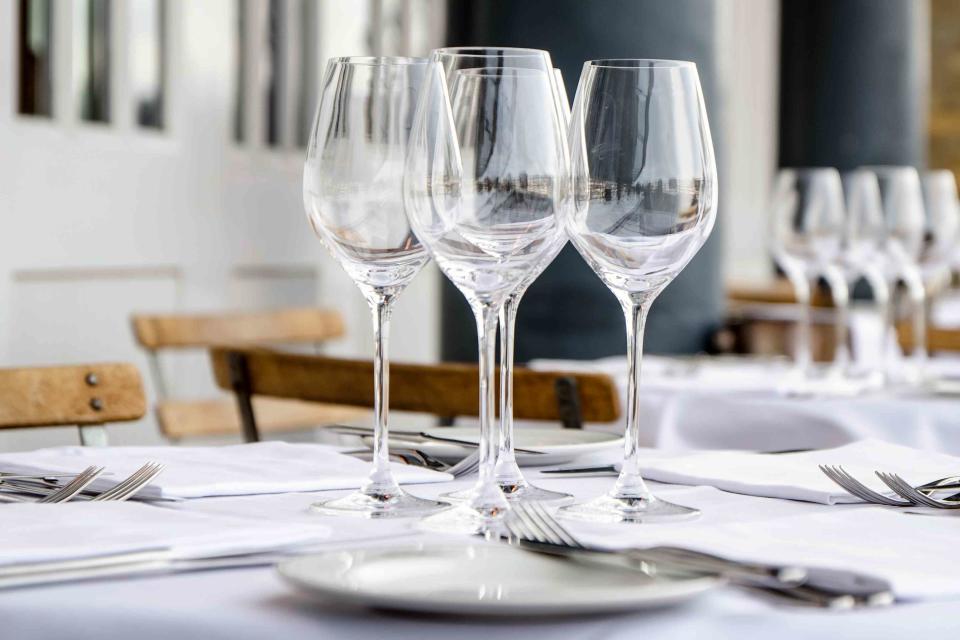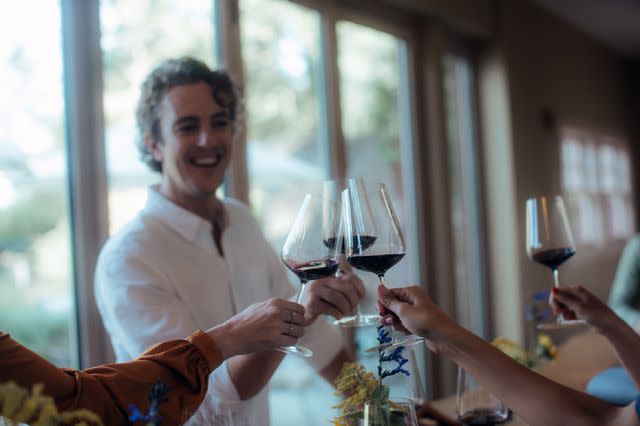What's in a Wine Glass? For Many Restaurants, It's Everything
One of the first things you touch when you sit down also happens to be one of the most powerful mood-setters.

Marc Dufresne / Getty Images
The fussiest of oenophiles might tell you that there's wine glass etiquette — do not serve a Burgundy in a Bordeaux glass, for god's sake.
But these days, most high-end restaurants — even the ones with wine menus tucked into thick, leather-bound tomes — keep their glasses simple: one for red and one for white. But what exactly does a restaurant intend to convey when they go with the $75 glass over a $3 option?
Flavor, sweetness, acidity, and body, as it turns out, aren’t everything, and the humble wine glass can go a long way to creating that certain something that chef-owners — and diners — crave when they go out to enjoy a bottle.
Ubiquitous at top-tier restaurants like Momofuku Ko and Manhatta, Zaltos –– exorbitantly priced, mouth-blown, whisper-thin sculptures that feel sensuous, precarious, and impossible –– are the height of luxury. At Burlington’s relaxed-but-sophisticated, small plates aplenty Dedalus wine bar, you’ll be served your wine in a $75 Zalto Universal glass, and while Dedalus’s Chief Marketing Officer Ashley Bryant says they do make the wine taste better and allow for enhanced nuance in the flavor, the choice is about so much more than the gustatory experience. While some higher end restaurants might only break out the Zaltos for guests who order a ball-out bottle, Bryant explains that using premium glasses for wine at any price point is part of a larger, concentrated effort to signal a welcoming attitude. “A big part of our guest experience is that good wine is not meant for only special occasions,” she says. “You can come in on a Tuesday and you can have a special moment with yourself or with friends or your community after work. You don't need to wait for a special occasion.”

Trefethen Winery / Winemonger Imports
Restaurant patrons toast with Zalto's Universal Glass.This emphasis on making the elite an everyday experience is showing up in other restaurants, too — with distinctly emotional reasoning.
:
Chase Sinzer, co-owner of Manhattan wine bar Claud, says their glasses — the Sophienwald white and Burgundy — aren’t particularly lower priced than Zaltos (each glass retails for € 44.40, or about $47), but they signal a more relaxed, lived-in vibe for the restaurant overall. Sinzer is clear that the glasses don’t act alone: A wine glass is just one component of the restaurant’s set of aesthetic and programmatic choices that create a specific guest experience, one of security and care. Still, it’s one of the first things a guest touches when they sit down at the table, maybe to test its heft or admire its shine. When it comes to setting a vibe, wine glasses can punch above their weight (no pun intended).
“I want them to feel that they’re in capable hands — first and foremost,” he says. Their Sophienwalds feel comfortably solid instead of dangerously fragile — enough to fit into the casual atmosphere Claud’s team works to create; As a matter of course, servers don’t use trays. “This is the first restaurant in 10 years where I'm picking three glasses up with my hands or chandeliering six glasses over to a six top,” Sinzer says. (Claud server Norberto Arenas is famed for his ability to carry upwards of twelve glasses in one hand — I’ve seen it happen, and it is magnificent.)
“It shows that we're comfortable with them,” Sinzer says. “We don't think they're as precious as they could be if you're gingerly bringing them over to the table in some performative way.”
“Wine is magical and precious on one level, but then also not,” says Orenda Hale, co-owner of Portland, ME’s Maine & Loire wine bar and shop. At the wine bar, guests drink out of Stolzle Exquisit 14.75 oz glasses. “We're trying to make [wine] feel like it's less exclusive, and having super fancy glassware sort of furthers that dichotomy of wine being only for a select few in America,” she says.
:
“One of the things we're trying to get people to understand is that wine is not necessarily just for special occasions or a splurge. It can be a part of your life as much as coffee, so our glasses are our version of the mug,” adds Maine & Loire’s other co-owner, Peter Hale,
Meanwhile, Lasita, Los Angeles’s buzzy Filipino rotisserie and natural wine spot, takes the approachable, casual vibe to an extreme with their Cristar Rioja 10 ounce glasses, which are big enough for a nice pour and a good swirl, but not ostentatious. The restaurant is “a party,” owner Chase Valencia emphasizes, explaining why he needed a glass that was versatile without feeling overly delicate. “The food is playful, hardy fare, and the dining room is lively. We wanted to find a wine glass capable of really withstanding all of the action, where you’re still able to get the nuances of the wine,” he says. The Cristars run his team $3.67 a piece, and they offer a familiar feeling: You’re at your friend’s house, you’re at home — the food and art is just better, and you don’t have to do the dishes.
Still, conveying emotional safety and comfort with a paper thin piece of glass perched on a wisp of a stem seems like an impossible proposition. With one wrong move — setting it down too quickly, knocking it over as you reach for the risotto, crushing it when your friend says something outlandish, and for a moment, your blood pressure spikes — you can turn it to shards. I couldn’t resist asking each person I spoke to: Do they break a lot?
In the case of the Zaltos, the answer is yes, of course they do, but they have a surprising amount of give and actually can bounce if you don’t drop them from too high, Bryant says. In Maine & Loire’s previous life as a full-scale restaurant (the beloved, late Drifter’s Wife), they broke their glasses regularly. Lasita sees a lot of breakage of its Cristars, too.
“[Even though] there's a lot of cheersing, and there's a lot of glasses being moved to make space for the lechon and the chicken, we pour the first sip [of wine] and then we leave the bottle at the table for the guests to pour themselves. It’s trust,” Valencia says.
The decision to use pricy glassware isn’t about signaling scarcity — in fact, it’s decidedly the opposite. At Dedalus what seems like an endless catalog of Zaltos hangs on view over the bar. One might break, sure, but there are hundreds more. It’s okay. At Claud, you might break a glass, but so might a member of the staff because they’re carrying 20 at once. At Lasita, the glasses cost less than four dollars each. Replacements are easy to come by. The night goes on.
The watering hole, the party, hospitality, trust, security: This sense of safety isn’t predicated on the idea that nothing ever breaks or goes wrong or makes a loud clatter that turns heads. It’s that for guests, the restaurant staff has you covered, from the lighting to the music to the plates to the wine list to the wine glass. Someone else is in charge — you don’t have to take the wheel. For tonight, from popping the cork to pouring to tasting to killing the bottle, you’re in good hands.

